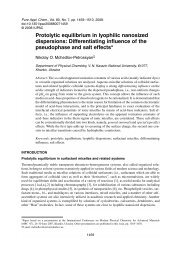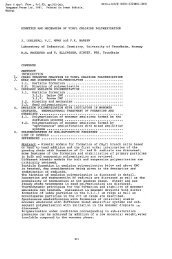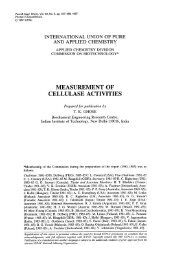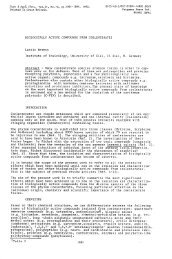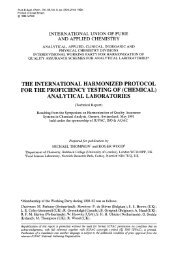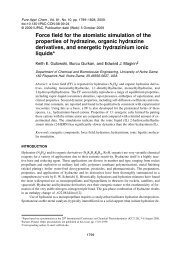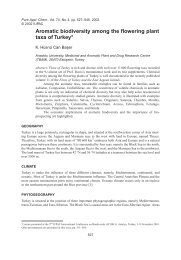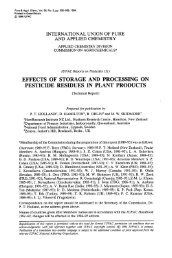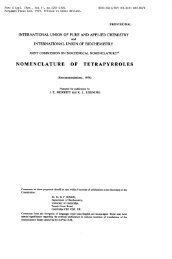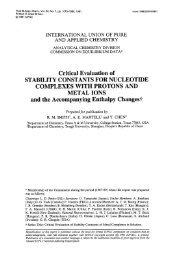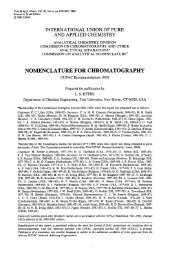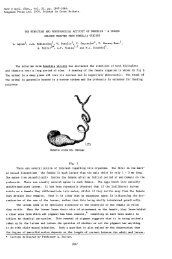Binuclear macrocyclic and macrobicyclic complexes for ... - IUPAC
Binuclear macrocyclic and macrobicyclic complexes for ... - IUPAC
Binuclear macrocyclic and macrobicyclic complexes for ... - IUPAC
You also want an ePaper? Increase the reach of your titles
YUMPU automatically turns print PDFs into web optimized ePapers that Google loves.
Pure & Appl. Chern., Vol. 66, No. 4, pp. 859-866.<br />
Printed in Great Britain.<br />
0 1994 <strong>IUPAC</strong><br />
<strong>Binuclear</strong> <strong>macrocyclic</strong> <strong>and</strong> <strong>macrobicyclic</strong><br />
<strong>complexes</strong> <strong>for</strong> dioxygen activation <strong>and</strong><br />
transport<br />
Arthur E. Martell, Ramunas J. Motekaitis, David Rockcliffe, Rached Menif <strong>and</strong> Patrick<br />
M. Ngwenya<br />
Department of Chemistry, Texas A&M University, College Station, Texas 77843-3255;<br />
Abstruct. The binuclear cobalt(I1) <strong>complexes</strong> of OBISTREN <strong>and</strong> OBISDIEN are<br />
excellent oxygen carriers because their dioxygen <strong>complexes</strong> do not undergo lig<strong>and</strong><br />
degradation <strong>and</strong> can give up their coordinated oxy en when subjected to a change of<br />
pressure or temperature. The additional coor8nation positions in OBISDIEN<br />
recognize <strong>and</strong> coordinate brid ing reducing lig<strong>and</strong>s which then undergo redox reactions<br />
with coordinated dioxygen. ahen isophphalaldeh de condenses with diethylenetriamine,<br />
the resultin Schiff base <strong>macrocyclic</strong> ligan J <strong>for</strong>ms a binuclear Cu(1) complex<br />
which reacts with d roxygen to <strong>for</strong>m a complex which rapidly hydroxylates an adjacent<br />
phenyl ring. When furan or pyridine is used in place of benzene the resulting dioxygen<br />
<strong>complexes</strong> may be used to oxidize substrates such as phenols, catechols, <strong>and</strong> aromatic<br />
amines. A catalytic cycle <strong>for</strong> the oxidation of 3,5-ditertiarybutylcatechol is shown.<br />
DIOXYGEN TRANSPORT<br />
The <strong>for</strong>mulas of the dinuclear hydroxo-bridged cobalt dioxygen <strong>complexes</strong> <strong>for</strong>med from OBIS-<br />
DIEN <strong>and</strong> OBISTREN'J are indicated by <strong>for</strong>mulas 1 <strong>and</strong> 2. The o enation constant is fairly<br />
normal <strong>for</strong> OBISDIEN but considerably below what is expected <strong>for</strong> 0 %f STREN. The OBISDIEN<br />
dioxygen com lex has three basic nitrogens per cobalt while the corresponding complex <strong>for</strong>med<br />
from OBISdEN with an additional basic rutrogen per metal ion has a stability which is almost<br />
three order of magnitude lower. Many examples have been given in the literature to indicate that<br />
the stabilities of dio gen <strong>complexes</strong> increase with an increase in the number of basic nitrogens<br />
coordinated to the co 2 alt. The stabilities of these two oxy en carriers are just the opposite of what<br />
one would redict, indicating that the OBISTREN comp B ex is much lower in stability than would<br />
be expectex The effect is probably a steric one because the oxy en <strong>complexes</strong> <strong>for</strong>med are quite<br />
normal in both cases, with strong charge transfer b<strong>and</strong>s around 5 70 nm <strong>and</strong>, as indicated by the<br />
<strong>for</strong>mulas, are diamagnetic in character, showing that the metal centers have the characteristics of<br />
cobalt(II1) <strong>and</strong> the bridging oxygen has the characteristics of a peroxo group.<br />
1 p-hydroxo-p-peroxo dicobalt(1l) 2 p-hyd roxo-p-peroxo dicobalt (I I)<br />
OBISDIEN dioxygen complex OBISTREN dioxygen complex<br />
The oxygenation constants shown above together with the stability constants of the metal<br />
<strong>complexes</strong> <strong>and</strong> the pK's of the lig<strong>and</strong>s can be used <strong>for</strong> setting up the distribution curves indicated<br />
859
860 A. E. MARTELL eta/.<br />
in Figures la <strong>and</strong> lb. For the distribution curves of the OBISDIEN oxygen complex (Fi re la) it<br />
is seen that the oxygen complex reaches its maximum concentration at a little over p €? 7 <strong>and</strong> at<br />
higher pH is converted from the monohydroxo to the dihydroxo <strong>and</strong> trihydroxo noxygen species. In<br />
the case of OBISTREN, however, onl one dinuclear cobalt dioxygen species is <strong>for</strong>med having a<br />
maximum concentration at about pH The coordination number of cobalt in this complex is 6 so<br />
that there is no tendency to <strong>for</strong>m the dihydroxo <strong>and</strong> trihydroxo species that is observed <strong>for</strong> the<br />
OBISDIEN dioxygen complex.<br />
100<br />
75<br />
% 50<br />
25<br />
0<br />
100<br />
75<br />
% 50<br />
25<br />
I'\'!A\ MIL<br />
2 3 4 5 6 7 8 9101112<br />
P[Hl<br />
Figure 1. Distribution of species as a function of p[H] in a solution containing a 1 :2 molar ratio L:Co(ll)<br />
at 25.0 OC,p = 0.100 M under 1 atm oxygen; A: OBISDIEN-Co(ll), [OBISDIEN] = 0.00100 M;<br />
B: OBISTREN-CO(ll), [OBISTREN] = 0.00100 M.<br />
An important feature of a good dioxygen carrier is the ability to undergo oxygenation <strong>and</strong><br />
deoxygenation many times without an appreciable degree of degradation. Man <strong>macrocyclic</strong> <strong>and</strong><br />
<strong>macrobicyclic</strong> lig<strong>and</strong>s have been used to <strong>for</strong>m dicobalt dioxygen <strong>complexes</strong> whic i carry oxygen but<br />
in almost all cases the rates of degradation are too rapid <strong>for</strong> commercial use as an oxygen carrier<br />
a half-life of a day or a even week is much too rapid). The oxygen carriers derived <strong>for</strong>m<br />
6 BISTREN <strong>and</strong> OBISDIEN, however, are notable in that the rates of degradation of the oxy en<br />
<strong>complexes</strong> is ve slow. The half-life of OBISTREN has been estimated as about six months whle<br />
that of the OBIYDIEN oxy en com lex seems to be three or four months. In addition to its high<br />
resistance to degradation t Efil e OBI TREN dicobalt peroxo bridge complex has a relatively low<br />
thermodynamic stability, with about 90% <strong>for</strong>mation at pH 8 at room temperature. At slightly<br />
higher temperature the degree of <strong>for</strong>mation is somewhat less, there<strong>for</strong>e the oxygen can be<br />
removed from the dioxygen complex by a moderate elevation temperature or a moderate decrease<br />
in pressure, making it fairly easy to recover the o en from the oxy en complex. For these<br />
reasons the oxygen complex derived <strong>for</strong>m the dicobalyfi) complex of OB B STREN seems to be the<br />
best oxygen carrier described in the literature thus far.3~4<br />
Several kinds of degradation of dioxygen <strong>complexes</strong> have been reported <strong>and</strong> Figure 2 illustrates<br />
three of the most common routes. In metal centered degradation the cobalt is converted to<br />
cobalt(II1) <strong>and</strong> hydrogen peroxide is released. There is no change in the lig<strong>and</strong> itself. Also, the<br />
oxygen corn lex may undergo li <strong>and</strong> centered degradation in which the li <strong>and</strong> is attacked by the<br />
dioxygen. d is attack may take t a e <strong>for</strong>m of a dehydrogenation reaction, inficatd by A of Figure 2.<br />
a<br />
b
<strong>Binuclear</strong> <strong>macrocyclic</strong> <strong>and</strong> <strong>macrobicyclic</strong> <strong>complexes</strong> 86 1<br />
Such a reaction is quite likely when there is an aromatic ring in the organic lig<strong>and</strong> so that a Schiff<br />
base can be <strong>for</strong>med in which the double bond of the Schiff base is conjugated with the ring.<br />
Lig<strong>and</strong>-centered degradation may also take the <strong>for</strong>m a hydroxylation reaction, as indicated in B of<br />
Fi re 2. An exam le of this kind of degradation will be shown below. Both the OBISDIEN <strong>and</strong><br />
ORSTREN dinuc f ear cobalt dio gen com lexes undergo metal centered degradation <strong>and</strong> the<br />
lig<strong>and</strong> in each case is not affecte? The CorUI) complex roduced by such degradation may be<br />
reduced to the original Co(I1) complex, which is the origin ap oxygen carrier.<br />
Metal-centered degradation<br />
Lig<strong>and</strong>-centered degradation<br />
+ 2H+<br />
Figure 2. Degradation of dioxygen <strong>complexes</strong>.<br />
Molecular Recognition<br />
The fact that the dioxygen complex of OBISDIEN has two aquo donors, one on each cobalt<br />
center, which are converted to hydroxo roups at hi h H, 3 <strong>and</strong> 4, suggests the possibili<br />
adding a third bridging group which woul d coordinate %i! ot metal centers simultaneously. Suc x a Of<br />
3 <strong>Binuclear</strong> hydroxo-bridged cobalt 4 <strong>Binuclear</strong> trihydroxo cobalt<br />
dioxygen OBISDIEN complex dioxygen OBISDIEN complex<br />
bridging group should have the correct size <strong>and</strong> shape to bridge the two metal ions <strong>and</strong> coordinate<br />
them simultaneously <strong>and</strong> thus be "recognized by the <strong>macrocyclic</strong> complex. If such a third bridging<br />
group is also a reducing a ent there is a possibility that it will react with the coordinated dioxygen<br />
within the macrocycle wit% the electron pathway from the reducin agent to the dioxygen through<br />
the metal ions. Bndging groups that meet these re uirements are t f e oxalate anion, a two electron<br />
reductant, <strong>and</strong> the mesoxalate anion (often calle ! ketomalonic acid), a four electron reductant.
862 A. E. MARTELL eta/.<br />
2<br />
The bridging e uilibria by these donors have been described includin the redox reactions in<br />
which the ligan is oxidized to C02 <strong>and</strong> the dioxy en is reduced to waterj6 The recognition by the<br />
dinuclear cobalt@ dioxygen complex of OBISD I% N of a number of bridging molecules or anions<br />
has been reported. .z<br />
In order to determine the affinity of mesoxalate <strong>for</strong> the OBISDIEN dicobalt dioxygen complex it is<br />
first necessary to take into account a number of other reactions which may or may not compete<br />
with the reaction in question. Such interactions are the bonding of mesoxalate to the free li <strong>and</strong>, 5,<br />
to the mononuclear OBISDIEN cobalt complex, 6, <strong>and</strong> to the dinuclear OBISDIEN &cobalt<br />
complex, 7. Whether or not these are competing reactions will de end on the equilibrium<br />
constants determined. Finally, the interaction of the mesoxalate with t I! e oxygen complex can be<br />
determined. It is noted that when the dioxygen complex, 8, is <strong>for</strong>med a hydroxo bridge IS also<br />
5 p-Mesoxalatohexaprotonted OBlSDlEN complex<br />
7 p-Mesoxalatodicobalt(l1) OBlSDlEN complex<br />
<strong>for</strong>med because of the increase in charge<br />
on the cobalt <strong>and</strong> its consequent higher<br />
tendencv to hvdrolvze. The distribution of<br />
the dioqgen' coniainin species in this<br />
system is shown in Sigure 3 which<br />
indicates that the maximum concentration<br />
of the dio gen complex in which<br />
mesoxalic aci 7 is also found occurs a little<br />
above pH 8. When the temperature of the<br />
solution is raised to about 50 OC a redox<br />
reaction between the coordinated<br />
dioxygen <strong>and</strong> the mesoxalate occurs in<br />
which the mesoxalate is converted<br />
entirely to CO The four electron<br />
oxidation which t&es place matches the<br />
oxidizing power of dioxy en to water <strong>and</strong><br />
the ori inal Co(I1) OBIS 8 IEN complex is<br />
<strong>for</strong>mecf after the redox reaction has been<br />
completed. The complex is thus available<br />
<strong>for</strong> combination wth more dioxygen<br />
which in turn can combine <strong>and</strong> react with<br />
more substrate. The reaction is there<strong>for</strong>e<br />
catalytic in nature, as is indicated by<br />
Scheme I. Thus we have a redox reaction<br />
which occurs within a <strong>macrocyclic</strong><br />
complex whereby a reducing agent<br />
supplies electrons to coordinated<br />
dioxygen which in turn is reduced to<br />
water.<br />
1 70<br />
v) ao<br />
6 p-Mesoxalaltotrlprotonated OBlSDlEN complex<br />
8 p-Hydroxo-p-peroxo dicobalt(ll1) OBlSDlEN complex<br />
Figure 3. Distribution of dioxygen complex<br />
species present as a function of p[H] in a<br />
solution containing a 1:1:2 molar ratio of<br />
OBlSDlEN (L) mesoxalic acid (HzA), <strong>and</strong> Co(ll),<br />
respectlvely, under 1.00 atm of dioxygen at<br />
25.0°C <strong>and</strong> p = 0.100 M (KCI). TA = TL =<br />
1/2Tcs(ll) = 2.00 x lo3 M. Non-dloxygen-<br />
containing species are omitted <strong>for</strong> clarity.
Scheme I<br />
<strong>Binuclear</strong> <strong>macrocyclic</strong> <strong>and</strong> <strong>macrobicyclic</strong> <strong>complexes</strong><br />
3c01<br />
3H'<br />
Dioxygen Activation<br />
While the dinuclear cobalt OBISDIEN complex described above may be inte reted as an<br />
activator of dioxygen, in that the oxygen complex can oxidize the substrates that a 'p so bridge the<br />
metal ion, the co per(1) dioxygen <strong>complexes</strong> are much more reactive in this regard. This section<br />
deals with examp P es of this type of oxygen activation.<br />
A 2+ 2 condensation of isophthalaldehyde with diethylenetriamine produces a tetra Schiff base<br />
<strong>macrocyclic</strong> lig<strong>and</strong>, 9, which combines with Cu(1) to give a com lex, 10, indicated in Scheme 11.<br />
This dinuclear complex combines with oxy en to ra idly hydroxy P ate one of the phenol groups of<br />
the <strong>macrocyclic</strong> lig<strong>and</strong> as indicated in the f! cheme.8, B The proof of hydroxylation was obtained by<br />
product analysis to indicate the <strong>for</strong>mation of the phenolic derivative <strong>and</strong> by an l80 tracer<br />
experiment in which all of the oxygen of the phenolic group was found to be derived from the<br />
original dioxygen. The oxygen insertion reaction is extremely rapid <strong>and</strong> the lifetime of the oxygen<br />
complex at room temperature is believed to be very short. However, KarlinlO was able to obtain<br />
spectroscopic evidence <strong>for</strong> a number of dinuclear &(I) dioxygen <strong>complexes</strong> at -80 OC, but which<br />
rapidly underwent oxygen insertion reactions or other degradation reactions at more elevated<br />
temperatures. r 1<br />
863
864 A. E. MARTELL eta/.<br />
In view of the high reactivity of the dioxygen complex indicated by 11 it was thou4ht that the use of<br />
a connecting group between the diethylenetriamine moieties in the <strong>macrocyclic</strong> nng that could not<br />
undergo insertion, as does an aromatic CH, would result in the <strong>for</strong>mation of copper(1) dioxygen<br />
<strong>complexes</strong> that would have a greater lifetime, especially at room temperature. Accordingly the<br />
dio gen complex with furan rings as bridging groups was prepared by Npenya" from the 2+2<br />
conyewation 2,5dicarboxaldehyde <strong>and</strong> diethylenetriamine. The resulting dioxy en complex<br />
indicated b 12 has a lifetime of about 2 hours at room temperature (- 25.0 OC) an % can be used<br />
<strong>for</strong> the oxidsltion of various substrates. The &(I) dioxygen complex 12 <strong>and</strong> an analogous complex<br />
containing YFdine connectin grou s, 13, were invest1 ated as oxidizing agents by<br />
Rockcliffe.129 714 The corresponing &I) <strong>complexes</strong> which di % not <strong>for</strong>m dioxy en adducts were<br />
also studied as oxidants. Table 1 lists the nine substrates that were investigated i! or reactivity with<br />
case. These reactions were carried out<br />
Five of the substrates where oxidized<br />
four substrates gave very low yields of<br />
11 12 13<br />
Table 1. Oxidations with [CU~(PD)~(DIEN)~]~+ <strong>and</strong> Dioxygen<br />
Substrate % Conversion Turnover Product<br />
2,6-dimethoxyphenol 46<br />
2,6di-f-butylphenol 56<br />
2,4di-f-butylphenol
Table 2. Oxidations with the CU~"(PD)~(DIEN)~~' Complex<br />
~~<br />
<strong>Binuclear</strong> <strong>macrocyclic</strong> <strong>and</strong> <strong>macrobicyclic</strong> <strong>complexes</strong> 865<br />
Substrate % Conversion Turnover Product<br />
2,6dimethoxyphenol<br />
2,6di-r-butylphend<br />
r-butyl hydroquinone<br />
2,4di-r-butylphend<br />
hydroquinone<br />
3,5di-r-butylcatechd<br />
4-t-butylcatechol<br />
4-methylcatechd<br />
3,4dimethylanillne<br />
46<br />
39<br />
64<br />
0<br />
35<br />
73<br />
0<br />
c1<br />
0<br />
2<br />
3<br />
6<br />
0<br />
3<br />
5<br />
0<br />
c1<br />
Table 3. initial Rates <strong>for</strong> Cu(i)-Dioxygen <strong>and</strong> Cu(ii) Oxidations<br />
Substrate Product<br />
0<br />
3,3' ,5,5' -tetramethoxydiphenoquinone<br />
3,3' ,5,5' -tetra-r-butyldiphenoquinone<br />
r-butylbenzoquinone<br />
benzoquinone<br />
3,5di-r-butyl-l ,2-benzoquinone<br />
-piactone of 3-hydroxy-4-<br />
methylmuconic acid ester<br />
2,6dimethoxyphenol 3,3' ,5,5' 4etramethoxydiphenoquinone<br />
2,6di-r-butylphend 3,3' ,5,5' -tetra-r-butyldiphenoquinone<br />
2,4di-r-butylphenol 3,3' ,5,5' -tetra-r-butyl-2,2' dihydroxybiphenyl<br />
hydroquinone benzoquinone<br />
r-butylhydroquinone r-butylbenzoquinone<br />
3,5di-r-butylcatechol 3,5di-r-butyl-l,2-quinone<br />
4-r-butylcatechd r-iactone of 3-hydroxy-4-r-butylmuconic<br />
acid ester<br />
4-methylcatechd r-lactone of 3-hydroxy-4-methylmuconic<br />
acid ester<br />
3,4dimethylaniline 3,3' ,4,4' 4etramethylazobenzene<br />
I 0.6<br />
S<br />
S<br />
S<br />
.<br />
S<br />
S<br />
S<br />
S<br />
S<br />
0 1.0. 20 3.0<br />
time, rnln<br />
initial Psuedo First<br />
Order Rate Constants, s-'<br />
Cu(i) t 02 Cu(ii)<br />
7.7 x 1.5 x 10-5<br />
6.7 x 10-5 1.2 x 10-5<br />
866 A. E. MARTELL eta/.<br />
The oxidation of 3,5-ditertiarybutylcatechol to 3,5-ditertiarybu 1-1,2-benzo uinone is illustrated<br />
by the cyclic process shown in Scheme 111. If one starts with the # inuclear Cub) dioxygen com lex,<br />
it is seen to combine with en to <strong>for</strong>m the peroxo bridged dinuclear Cu(1) complex in whic: the<br />
metal ion is indicated as ) with a bridgin peroxo grou . This combines with the substrate in<br />
the<br />
to give the &rnethoq bri B ged Cu(I1) complex <strong>and</strong> one mole of<br />
the quinone. The Cu(I1) complex in turn oxidizes another mole of the substrate to the quinone<br />
fomng the Cu(1) dioxygen complex <strong>and</strong> the cycle then repeats itself. A similar scheme can be<br />
written <strong>for</strong> all of the substrates in Table 1 that undergo catalytic oxidation.<br />
Scheme I11<br />
a'+<br />
2CH30H<br />
' '0) 2 CH30H<br />
/ +<br />
Acknowledgement: This research was supported by The Robert A. Welch Foundation (Grant A-<br />
259) <strong>and</strong> by the Office of Naval Research.<br />
References<br />
1. R. J. Motekaitis, A. E. Martell, J. P. Lecomte <strong>and</strong> J. M. Lehn, m. Chem. 22, 609-614 (1983).<br />
2. R. J. Motekaitis, A. E. Martell, J. M. Lehn <strong>and</strong> E. I. Watanabe, m. Chem. 21, 4253-4257 (1982).<br />
3. R. J. Motekaitis <strong>and</strong> A. E. Martell, J. Chem. SOC. Chem. Commun., 1020-1022 (1988).<br />
4. R. J. Motekaitis <strong>and</strong> A. E. Martell, d. Am. Chem. SOC. 1 lQ, 7715-7719 (1988).<br />
5. A. E. Martell <strong>and</strong> R. J. Motekaitis, d. Am. Chem. SOC. 110, 8059-8064 (1988).<br />
6. R. J. Motekaitis <strong>and</strong> A. E. Martell, ma. Chem. 34,694-700 (1991).<br />
7. R.J. Motekaitis <strong>and</strong> A. E. Martell, m. Chem. 31, 5534-5542 (1992).<br />
8. R. Menif <strong>and</strong> A. E. Martell, d. Chem. &. Chern. Commun., 1521-1523 (1989).<br />
9. R. Menif, A. E. Martell, P. J. Squattrito <strong>and</strong> A. Clearfield, m. Chern. 29, 4723-4729 (1990).<br />
10. 2. Tyeklar <strong>and</strong> K. D. Karlin, &. Chem. Res. 22,241-248 (1989)<br />
11. M. P. Ngwenya, D. Chen, A. E. Martell <strong>and</strong> J. Reibenspies, m. Chem. a, 2732-2736 (1991).<br />
12. D. A. Rockcliffe <strong>and</strong> A. E. Martell, J. Chem. Soc. Chern. Comrnun., 1758-1760 (1992).<br />
13. D. A. Rockcliffe <strong>and</strong> A. E. Martell, m. m., in press.<br />
14. D. A. Rockcliffe <strong>and</strong> A. E. Mattell, to be submitted.



